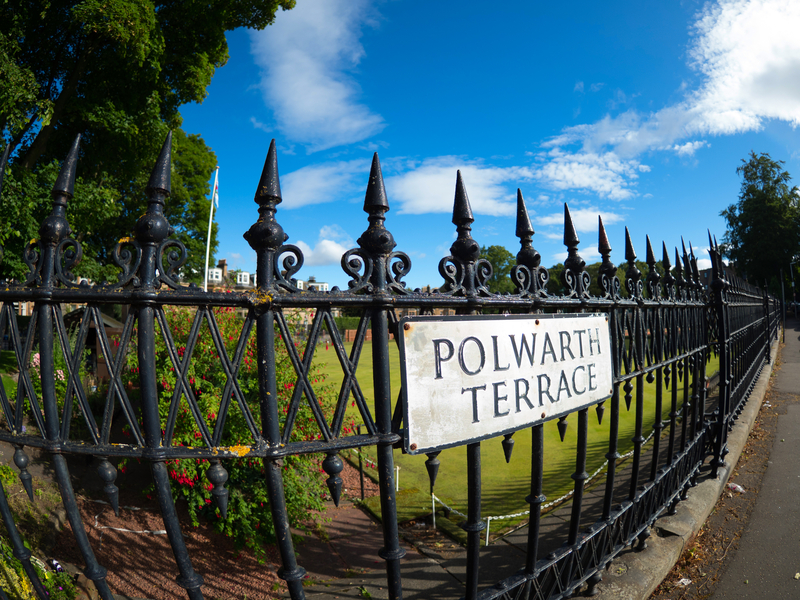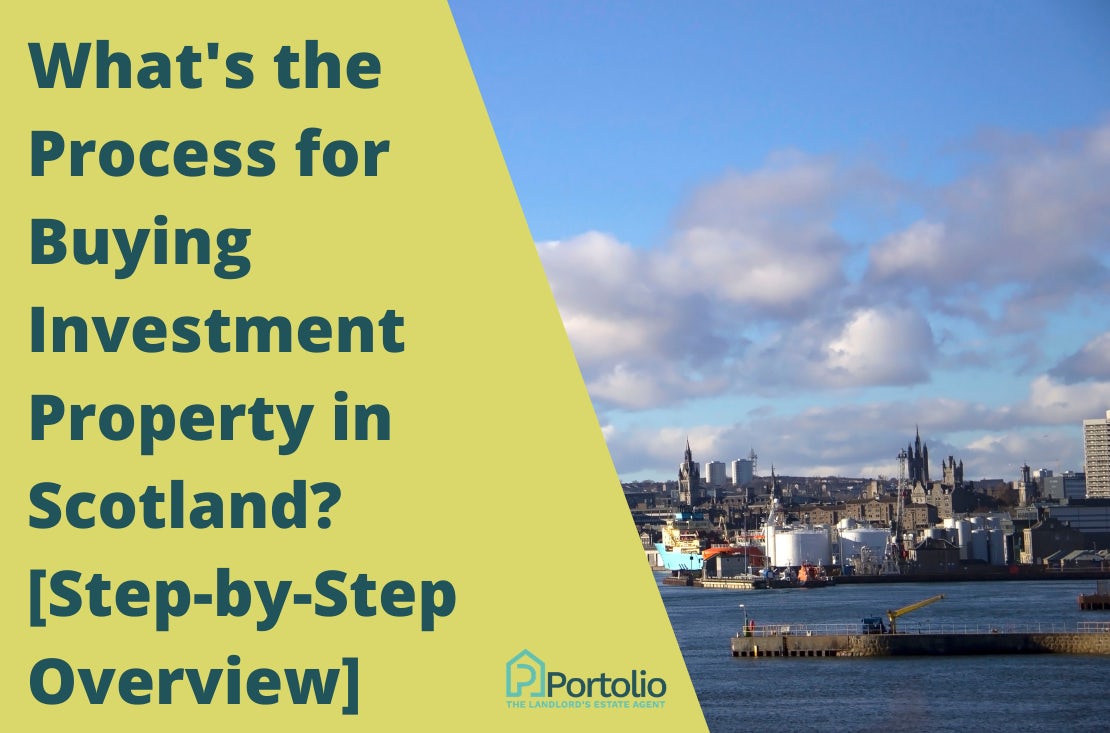Are you an overseas investor interested in buying investment property in Scotland?
If you are, and have yet to dip your toe in the Scottish property market, you’re probably eager to get a better understanding of the process involved, and how property investment in Scotland works.
Here at Portolio, we’ve received more enquiries recently from overseas property investors who see Scotland as an attractive prospect, due to its affordable properties, good capital growth, high rental demand, and huge potential for returns.
That’s why, as a co-founder of Scotland’s only estate agent for landlords, I feel it’s my responsibility to help shed some light on how buy-to-let investment in Scotland operates, and the process you’ll go through – so, when you do spot a great opportunity, you will be prepared.
In this blog post, I’ve reviewed the entire process, step-by-step, as well as alerting you to a smart way you can bypass some of the extra hassle and expenses associated with overseas buy-to-let investment in Scottish property.
TIP: For more tips on overseas Scottish property investment, check out our recent blog on the subject – you might get some good extra takeaways from it!
Before you begin… be prepared
This is something we’ve discussed in blogs before, but it’s worth repeating here; be prepared. Of course, a good way to be prepared for the entire buying process is to read this blog – so, you’re on the right track.
So, what do I mean by ‘be prepared’?
First, it’s a good idea to do a bit of research on the property market in Scotland (and in the UK), and understand the fragmented nature of property values in different areas. This will go a long way to understanding what you can get for your money.
Be aware of your setup costs, be mindful of your overall investment strategy, and get any funds in place so you are ready to make a move.
But just as important is to assemble a team of professionals you trust.
This includes a solicitor, a specialist estate agent (who is experienced in dealing with overseas property investors), a letting agency, a mortgage broker (unless you’re a cash buyer) and an accountant.
Having the right team on your side is absolutely essential, and will ensure you feel confident when making those big decisions.
The process for buying investment property in Scotland
This is the part you came here for. Below, I’ve guided you through each step you need to take when sourcing and purchasing an investment property in Scotland – hopefully with a team of the right people on your side.
Step 1: Request the home report
For every single property that is on the market, there is a home report survey.
This is a prerequisite to any open market sale, and is conducted by a surveyor who visits the property, and records all the details to give potential buyers, like you, a better understanding of the property.
The home report details any notices, changes, or issues with the property, along with a valuation based on the current market, and how other properties have sold in the street or surrounding areas.
If you see a property you’re interested in, your best first step is to request a copy of the home report, so you can get a quick overview of the property and all the information you need to know ahead of a viewing – or making an offer to purchase.
WOW! Before anyone is able to sell a property on the open market in Scotland, they must get a home report – and it’s a big plus for buyers. This is in contrast to England, where the buyer has to pay for the survey themselves.
Step 2: Organise a viewing
Assuming you’re happy with the details in the home report, your next step is to organise a viewing.
If you are an overseas property investor, depending on where you are in the world, this may be a purely virtual viewing – or, if you are locally based, you may also wish to physically view the property.
TIP: Virtual viewings are the future, and here to stay, with many estate agents now offering both 3D virtual walkthroughs of properties, and live virtual viewings.
Currently, due to recent COVID circumstances, physical property viewings in Scotland are mainly reserved for serious buyers, so we recommend always requesting a virtual viewing first, and taking it from there.
When attending a physical viewing, ensure you follow the current guidelines to ensure your safety, and the safety of all parties involved.
Step 3: Put in your offer
You’ll have noticed when you received the home report survey, how much the surveyor deemed the property to be worth. However, the type of offer you submit may very well depend on who’s selling, as well as the location and type of property it is.
It’s very common for properties to be advertised as ‘offers over’ a certain amount – and that amount doesn’t always reflect the home report value (usually it’s £5k – £10k less). This is a good way to ensure a lot of interest in a property.
You may also see ‘offers around’ and ‘fixed price’ properties advertised, although this is less typical.

The verbal offer
Not everyone is aware they can submit a verbal offer directly to the estate agent. This is an informal offer that can be considered by the seller. Once the agent has confirmation that the verbal offer is accepted, you can then move onto your formal offer.
NOTE: Sometimes, moving quickly can make a difference. Buyers don’t always realise it’s possible to submit a verbal offer first – you never know, it might be successful!
The formal offer
A formal offer needs to be submitted via a Scottish-based solicitor. If the formal offer is accepted, then congratulations! It’s time to move onto the next step.
However, if your offer is not accepted, you may wish to reconsider your offer and resubmit (or move on). It’s quite common – particularly in the homebuyer market – for properties in Scotland to go to a closing date where blind bids are submitted, especially if the property has multiple offers or the seller prefers this method.
The world of property investment can be quite different, which is why we always recommend submitting a verbal offer first and seeing the response you get.
In general, property investors do not want to get involved in closing dates – because it may lead to paying far too much, or wasted time, and wasted effort.
Step 4: Agree the missives (or keep looking)
Let’s assume for the purposes of this blog that you’ve been successful with your offer and you have secured the property.
Now it’s time for the next stage of the process, which is conveyancing. This involves sharing and agreeing the missives, and contracts. Usually this can take around 6 – 8 weeks for lending (currently 10 – 12 weeks due to the volume of mortgage applications), or 2 – 4 weeks if you’re a cash buyer.
Pssst! For those reading outside of the UK and unfamiliar with Scottish legal terms, ‘conveyancing’ is the action of preparing documents for the legal transfer of property, whereas ‘missives’ refer to a document in the form of a letter exchanged by the parties to a contract.
During the process of transferring ownership, your solicitor will check things such as:
- Whether the seller officially owns the property (this is just a formality)
- Looking for unusual conditions in the title deeds that could affect you letting out the property to tenants
- Ensuring there aren’t any burdens (like legal limitations on refurbishments or renovations to the property)
- Making you aware of any legal obligations to let someone else use the land or stop you from using it
- Ensuring that the existing mortgage is paid off when the property is transferred to you
Step 5: Collect your keys!
Once ownership has been transferred to you, it’s time to collect your keys. If you’re buying an empty property, it’s then up to you to get it ready for tenants (more about that in Step 6).
However, if you’re buying an already tenanted property, you have to be aware of a couple of extra things, such as the tenancy deposit scheme, and ensuring the tenancy is transferred over to you (the latter is actually really simple, read more here).
NOTE: Collecting keys may be a metaphorical term if you are buying UK property from abroad, or buying tenanted property. BUT certainly, something has to be done with the keys!
Essentially, the tenancy agreement simply changes hands, and you’ll be bound by the tenancy in the same way as the old landlord was. The tenants still retain their legal rights, and the same laws and rules are applied. Most of the time, a new tenancy agreement isn’t required.
Step 6: Find/instruct your letting agent
If your buy-to-let is purchased with vacant possession – as opposed to already tenanted – you will now have to ‘let it out’, and commence all the various tasks associated with that.
A good letting agent should be able to help you with this, especially when buying from overseas, to ensure the property is fully compliant and safe for tenants – as well as carrying out a rent evaluation for you, before finding you some tenants.
It’s worth bearing in mind, especially if you are an overseas UK property investor purchasing long distance, that you may need additional help preparing the property, which could include things like redecorating, furnishing, and the purchase of white/electrical goods.
TIP: The costs of buying investment property in Scotland can quickly add up – for more of an idea of what to expect – and how you can save on them – check out this blog we recently published.

Or… skip step 5 & 6, and receive instant rental income from Day 1
If your goal is to invest in buy-to-let in Scotland, you might not be aware that there is a way to bypass much of the costs, frustrating gaps in revenue, and hassle of purchasing a buy-to-let.
By buying a fully-compliant, fully-furnished property with the tenants still inside, you can receive rental income on Day 1 – without having to jump through some of the hoops above!
When investing in a tenanted property, you will know the rent being paid, and have peace of mind knowing you’re getting a good tenant. In short, you’ll be making a safe, savvy, and well-informed UK property investment.
You’ll even be able to see your exact yield, and have peace of mind knowing you’re getting a good tenant. Also, when your buy-to-let property is already tenanted, you know that it has passed all the required safety tests (incl. electrical and gas) for letting.
You can also save on a lot of the costs we’ve mentioned above, therefore maximising your cashflow – and chances are, you’ll even be able to keep the same letting agent for continuity.
From the Portolio database, and the clients we’ve helped to buy Scottish properties, we’ve built up a firm belief that buying UK property with instant rental income is the way forward when working with international (and otherwise) clients.
TIP: For a better understanding of all the benefits of investing in tenanted property, check out our recent blog post.
Advice from the property pros
I know I’ve mentioned the importance of having a team you can trust, but I’m going to expand on that a little more, because it’s vital you choose the right, experienced team of individuals. Don’t forget to check third-party reviews, and testimonials.
When buying investment property in Scotland, it’s particularly important to ensure that the solicitor you choose is based in Scotland, and governed by the Scottish Law Society. This is because there are different rules and regulations in Scotland compared to the rest of the UK.
When you have people on the ground who have your best interests at heart – especially property experts who fully understand the world of UK buy-to-let investing – and can start looking around for the best investment opportunities for you, you won’t go far wrong.
In summary
Buying investment property in Scotland, when you’re overseas, doesn’t have to be daunting.
As long as you’re able to assemble the right team of professionals and property specialists who can identify opportunities, you’ll be all set.
One of the best ways to invest in buy-to-let in Scotland is to purchase tenanted property, therefore bypassing some of the steps I’ve mentioned above.
If you would like to learn more about buying investment property in Scotland, and investing in tenanted property in particular, feel free to get in touch.
We’re happy to listen to what you’re trying to achieve, and provide some free, no-strings advice – or at least point you in the right direction.
Happy investing!
Written by Ross MacDonald, Director of Sales & Co-founder of Portolio
Get in touch on 07388 361 564 or email to [email protected]



Comments